Table of Contents
What is a Network Controller?
A network controller is a crucial component in the management and control of computer networks. These controllers can be either hardware devices or software programs designed to monitor, manage, and optimize network traffic, packet forwarding, security, and overall performance. By leveraging network controllers, administrators can oversee the network’s operational status and enhance resource allocation, thereby improving network efficiency and reliability.
Why Do We Need Network Controllers?
In today’s digital age, networks are the backbone of modern organizations. They provide not only basic connectivity but also ensure security, facilitate enhanced collaboration, maintain quality of service, and ensure business continuity. The architecture, infrastructure, and management of these networks are vital to the success of any business. Network controllers play a pivotal role in orchestrating all aspects of the network to ensure seamless operation and alignment with business objectives.
Evolution of Network Controllers:
Early Tools: Element Management Systems (EMS)
Initially, Element Management Systems (EMS) were used to control network devices. These systems could monitor and manage specific groups of devices but lacked comprehensive network control. They incorporated functionalities like Fault, Configuration, Accounting, Performance, and Security (FCAPS) and used northbound APIs to integrate with higher-level applications. However, their proprietary nature limited their usefulness to small groups of devices.
Software Defined Networking (SDN) Controllers
Software Defined Networking (SDN) controllers emerged to address the need for automation and agility in network management. These controllers are application-driven, providing a centralized, programmable point of automation that can manage, configure, monitor, and troubleshoot virtual network infrastructure. However, SDN controllers alone do not offer all the features required for a fully responsive network.
Modern Network Controllers
Modern network controllers combine and extend the capabilities of EMS and SDN controllers. They enable IT teams to achieve streamlined, centralized, and agile operations. These controllers provide automation, performance analysis, fault detection, and correction, helping organizations achieve their desired business outcomes.
How Network Controllers Work?
Network controllers operate through two main types of APIs:
- Southbound API: This allows the network controller to communicate with and manage network devices, services, and components. It collects necessary information about the network and ensures that configurations align with the desired state.
- Northbound API: This enables management applications to inform the network controller of the desired network settings and services.
By continuously monitoring the state of network devices and services, network controllers ensure that any deviations from the desired configurations are corrected promptly.
Key Tasks of Network Controllers:
Network controllers perform several critical tasks, including:
- Automatic Discovery of Network Topology: Identifying and mapping out the network’s structure.
- Automated Device Operations: Performing tasks such as configuration and image updates automatically.
- Device Inventory Management: Keeping track of devices and their statuses within the network.
- Unified Device Management: Providing centralized management for all network devices.
- Multi-Dimensional Network Monitoring: Continuously monitoring various aspects of network performance.
- Network Analysis and Problem Identification: Analyzing network operations to identify potential issues and propose solutions.
- Automated Operation and Maintenance: Streamlining routine maintenance tasks through automation.
By performing these tasks, network controllers ensure that networks operate efficiently, securely, and in alignment with business goals.
What are the advantages of enterprise deploying network controllers?
In today’s fast-paced digital landscape, IT teams face mounting pressure to deliver seamless network experiences. One solution stands out for its potential to transform operations: the network controller. By deploying a network controller, enterprises can unlock a wealth of benefits that drive down costs, improve availability, enhance flexibility, and bolster security.
- Slash Operational Costs:Skyrocketing operational expenses pose a significant challenge for IT departments. As the number of users and devices balloons, traditional management methods struggle to keep pace. Network controllers offer a powerful antidote. By automating operations, these solutions enable greater scalability, reduce time spent on management, eliminate errors, and ultimately cut costs.
- Ensure Always-On Availability:Downtime is a costly enemy of productivity. Network controllers help ensure your network services remain always available. These intelligent solutions collect and analyze traffic data to proactively pinpoint potential issues before they disrupt operations. With root cause analysis and timely alerts, IT teams can take swift corrective action to prevent problems from arising in the first place.
- Boost Flexibility and Responsiveness:In today’s dynamic business environment, agility is key. Network controllers make your network a powerful enabler of organizational needs. With the ability to implement changes consistently and universally across all devices, these solutions eliminate the tedium of manual configuration. The result? A network that flexes and adapts to your business.
- Fortify Your Security Posture:In an era of escalating threats, robust security is paramount. Network controllers offer a potent defense. Through in-depth traffic analysis, these solutions can uncover potential threats lurking in the shadows. With the power to isolate and contain dangers, network controllers help prevent malicious activity from spreading and safeguard your network integrity.
Classifications of Network Controllers
Let’s explore several key classifications of network controllers, each serving distinct roles in managing and optimizing various aspects of network infrastructure:
WLAN Controller (Wireless Local Area Network Controller)
WLAN controllers are specialized devices used to manage and control access points (APs) within wireless local area networks (WLANs). They handle tasks such as allocating wireless frequency bands, adjusting transmission power, and maintaining wireless connections and security policies. By centrally managing multiple APs, WLAN controllers simplify the deployment and maintenance of wireless networks, ensuring stability, security, and optimal performance.
Switch Controller
Switch controllers are designed to manage and control network switches. They enable the configuration, monitoring, and troubleshooting of switches, ensuring their normal operation and optimized performance. Switch controllers play a crucial role in maintaining the efficiency and reliability of network switch operations.
SDN Controller (Software-Defined Networking Controller)
An SDN controller is integral to software-defined networking (SDN) architecture, which separates the network control plane from the data forwarding plane. This centralized approach allows network administrators to manage and control network traffic through a flexible and programmable interface. SDN controllers enable the configuration, management, and optimization of networks, providing a centralized point of control that enhances network agility and efficiency.
Network Traffic Controller
Network traffic controllers monitor and manage network traffic by analyzing, identifying, and classifying different types of traffic. They implement management policies for traffic scheduling, load balancing, and traffic optimization, thereby improving network performance and user experience. These controllers are essential for maintaining the smooth flow of data and preventing network congestion.
Bandwidth Controller
Bandwidth controllers manage and control the allocation of network bandwidth. They can impose limits on bandwidth usage for specific users or applications, ensuring fair sharing of network resources and preventing congestion. Bandwidth controllers are particularly important for organizations and service providers to optimize network performance and enhance user experience by avoiding bandwidth abuse.
Open Source Network Controllers – OpenWiFi Compatible Controller
Open-source network controllers, such as those compatible with OpenWiFi, offer a cost-effective and flexible solution for managing network components.
OpenWIFI is a great open source project about WIFI systems. For more:https://telecominfraproject.com/openwifi/
By adhering to the TIP-OpenWiFi technical community standard, these controllers pave the way for uniform management of compliant APs and switches. This means no more struggling with differnet vendors’ compatibility issues. It’s all about simplicity and efficiency.
By leveraging the powerful and unified codebase of OpenWiFi, organizations can develop advanced enterprise-level open WiFi and open LAN solutions, maximizing their investments and creating unique business services.
For end users, this technology isn’t just a game-changer; it’s a liberator. Say goodbye to vendor lock-in and sky-high equipment costs. With this technology, end customers can finally enjoy open, flexible networks that are within reach. It’s a paradigm shift that enables businesses to avoid vendor lock-in, reduce expenses, and effectively lower TCO.
Asterfusion OpenWiFi Compatible Controller-Asteria: Empowering OpenWiFi and OpenLAN Switching
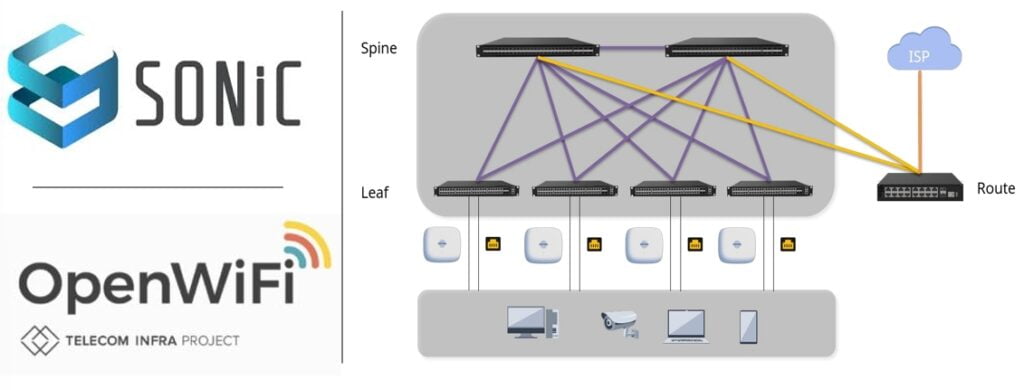
The Asterfusion OpenWiFi Controller is a cornerstone of the Asterfusion OpenWiFi and OpenLAN Switching Solution, designed to elevate your enterprise network management experience.
Our range of self-developed OpenWiFi Access Point (AP) devices, all equipped with the CloudSDK controller, can meet the most diverse networking needs. But that’s just the beginning.
We’re excited to announce that Asterfusion’s enterprise SONiC NOS-based Layer 2/3 switches now be effortlessly managed throughwith our TIP-based Open WiFi Controller. This means you can effortlessly manage your entire network, from wireless APs to Layer 2 access switches and Layer 3 aggregation switches, all from a single intuitive interface.
Imagine having complete visibility and control over every corner of your campus network, with the ability to optimize performance, troubleshoot issues, and scale your infrastructure with ease. That’s the power of Asterfusion’s OpenWiFi and OpenLAN Switching solution,taking your network management from wireless to wired to the next level!
-
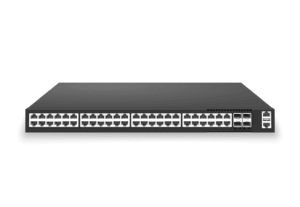 48x1G RJ45 L2/3 Access Switch, 4x25Gb/10Gb SFP28 Uplinks, Enterprise SONiC Ready
48x1G RJ45 L2/3 Access Switch, 4x25Gb/10Gb SFP28 Uplinks, Enterprise SONiC Ready -
 24x1G RJ45 POE+@370W L3 Access Switch, 4x25Gb/10Gb SFP28 Uplinks, Enterprise SONiC Ready
24x1G RJ45 POE+@370W L3 Access Switch, 4x25Gb/10Gb SFP28 Uplinks, Enterprise SONiC Ready -
 24x1G RJ45 L2/3 Access Switch, 4x25Gb/10Gb SFP28 Uplinks, Enterprise SONiC Ready
24x1G RJ45 L2/3 Access Switch, 4x25Gb/10Gb SFP28 Uplinks, Enterprise SONiC Ready -
 48x1G RJ45 L2/3 Access Switch, 6x25Gb/10Gb SFP28 Uplinks, Enterprise SONiC Ready
48x1G RJ45 L2/3 Access Switch, 6x25Gb/10Gb SFP28 Uplinks, Enterprise SONiC Ready
-
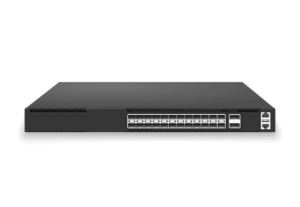 24x25G SFP28, 2x100G QSFP28 Uplinks, L3 Core/Leaf Switch, Enterprise SONiC Ready
24x25G SFP28, 2x100G QSFP28 Uplinks, L3 Core/Leaf Switch, Enterprise SONiC Ready -
 24-Port 10Gb SFP+L3 Aggregation with 6-Port 100Gb QSFP28 Uplink Enterprise SONiC Ready
24-Port 10Gb SFP+L3 Aggregation with 6-Port 100Gb QSFP28 Uplink Enterprise SONiC Ready -
 16x10Gb SFP+, 2x100Gb/40Gb QSFP28 QSFP+ L3 Leaf&Core Switch, Enterprise SONiC Ready
16x10Gb SFP+, 2x100Gb/40Gb QSFP28 QSFP+ L3 Leaf&Core Switch, Enterprise SONiC Ready -
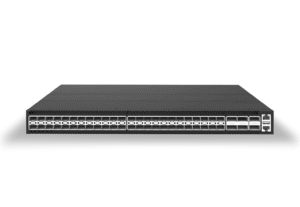 48x10Gb SFP+, 6x100Gb QSFP28 L3 Leaf & Core Switch, Enterprise SONiC Ready
48x10Gb SFP+, 6x100Gb QSFP28 L3 Leaf & Core Switch, Enterprise SONiC Ready
Simplify the Control & Management of your Wired & Wireless Networks through OpenWIFI+Enterprise SONiC
The Asterfusion TIP OpenWiFi Cloud Controller offers centralized management and visibility for all TIP OpenWiFi devices within a cloud-based campus network. This includes everything from wired to wireless, APs to layer 2 access switches, and Layer 3 switches.

Asterfusion innovative open LAN switching solution incorporates full-size SONiC NOS on dual A53 processors within our PoEswitch. This means seamless ZTP for hundreds of switches and WiFi APs, all from a dual-core EC2 instance. With the Asterfusion cloud campus architecture, we deliver a robust, scalable, and turnkey campus access switching solution. It’s all based on SONiC NOS and fully compatible with OpenWiFi technology.
Asterfusion OpenWiFi Compatible Controller Highlights:
- Unified management of wired and wireless networks
- Auto deployment and configuration using ZTP
- Automatically topology showing
- Real-time network status monitoring
- Automated operation using pre-defined scripts
- Integrated to Openstack with Neutron plugin
- Comply with OpenWiFi standard
- ZERO license cost for on-prem deployment
Centralized Management
The Asterfusion OpenWiFi Controller supports deployment both on the cloud and locally,providing a unified management platform for both wired and wireless networks.
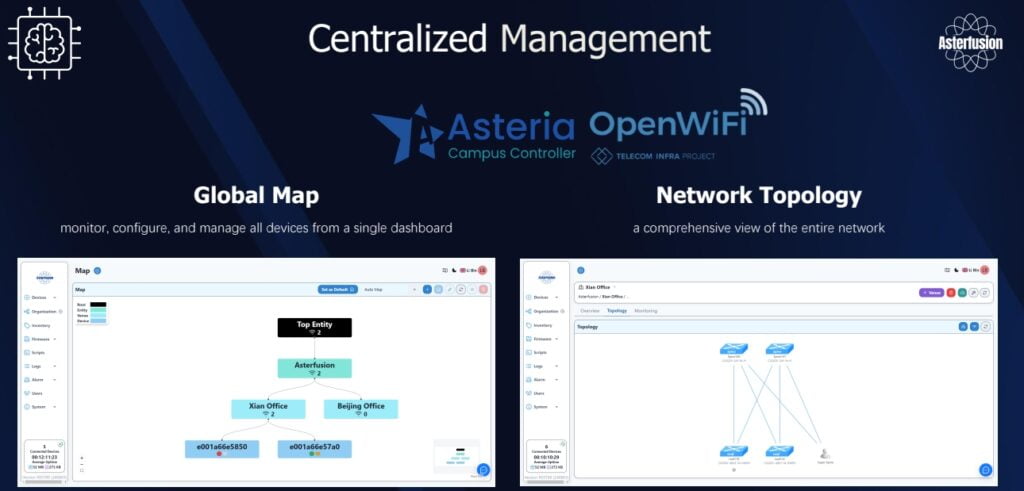
Automated Operation
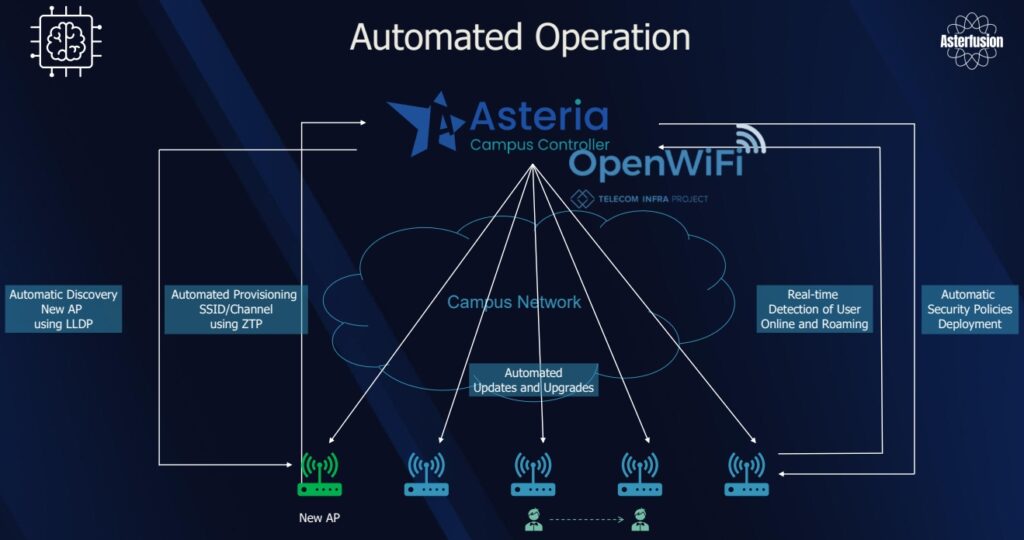
- Automatic Discovery New AP using LLDP
- Automated Provisioning SSID/Channel using ZTP
- Automated Updates and Upgrades
- Automatic Security Policies Deployment
Simplified Deployment
Administrators can access the controller from mobile terminals connected to the network anytime and anywhere, allowing real-time device management.
The controller builds the network topology through administrator input or automatic learning, generates configuration scripts based on the network topology and business planning, and sends them to multiple selected devices with one click. This process eliminates the need for manual configuration commands, significantly reducing learning costs and error rates, making the configuration and deployment of a full three-layer cloud network easier than ever before.
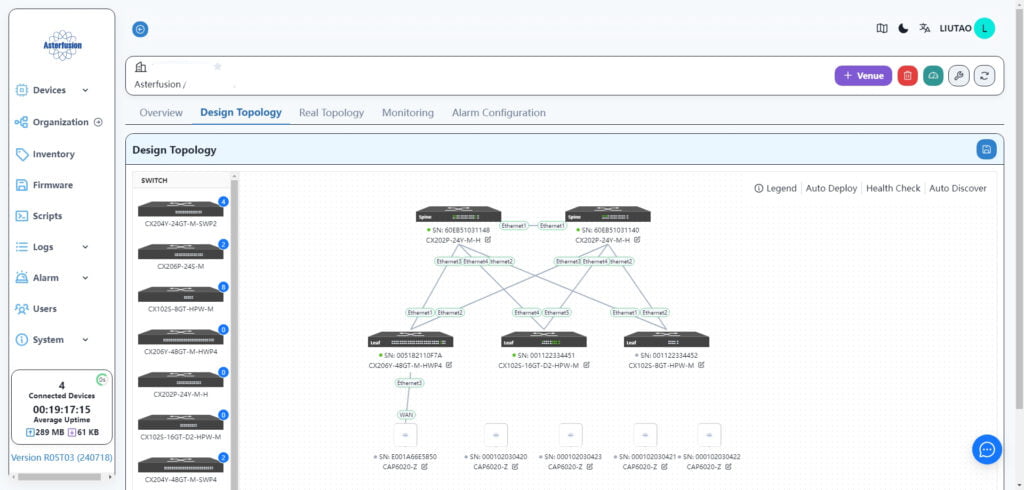
Comprehensive Operations & Maintenance Management
Stay ahead of potential issues before they impact your network. Asterfusion OpenWIFI controller delivers robust, real-time monitoring of switch and wireless AP health, giving you a complete view of device status at a glance. With intuitive dashboard displays, you’ll always have a pulse on operational readiness. It goes beyond basic monitoring. It intelligently analyzes key indicators to calculate a health score for each device, alerting you to potential problems before they occur. Factors considered include:
- Resource Utilization: Proactively identify risks of memory or CPU exhaustion.
- Traffic Load: Pinpoint potential bottlenecks based on in-depth traffic analysis.
- Hardware Status: Ensure components are operating within safe temperature ranges, and that power supplies and fans are functioning correctly.
- Operational Status: Get real-time visibility into the status of critical device processes and containers.

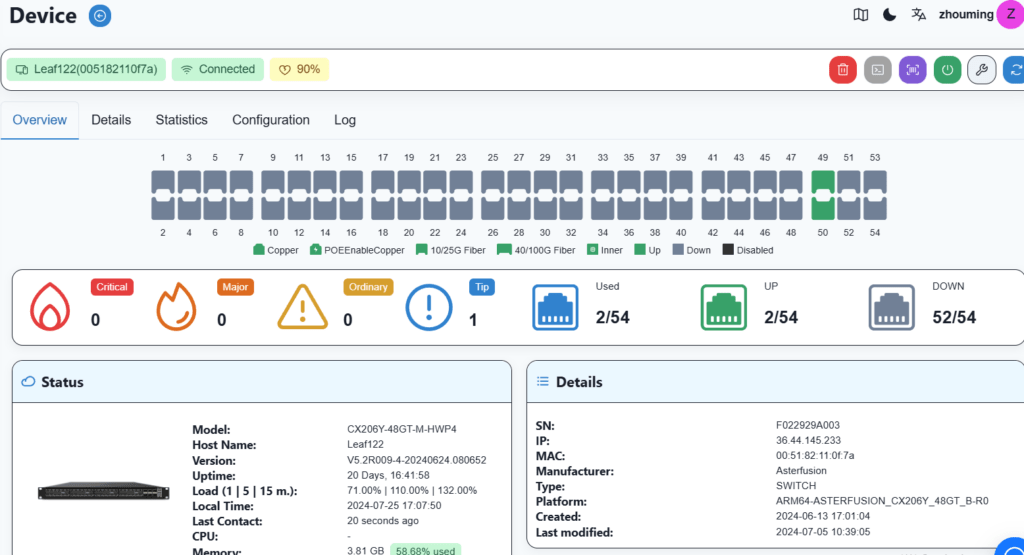
User-Friendly Interface
With its intuitive interface, the Asterfusion controller simplifies network operations, reducing the workload and error rates associated with manual configurations. Administrators can manage devices in real-time from any mobile terminal connected to the network, making the configuration and deployment of a three-layer cloud network easier than ever before.
Asterfusion OpenWiFi Compatible Controller Specifications List by 2024 Q3
The Asterfusion OpenWiFi Controller is a robust and innovative solution that enhances network management, reduces costs, and fosters innovation. The centralized management simplifies daily operations and maintenance, enhancing overall efficiency . This solution empowers IT professionals with greater network deployment options, avoiding dependency on a single vendor and offering a cost-effective approach that maximizes investments.
Take your network management to the next level with Asterfusion. Discover a smarter way to connect your campus, from wired to wireless and every point in between.
Free OpenWIFI Controller & Free Trials Available
That’s right – our OpenWIFI controller is currently being offered for free with the purchase of a switch. It’s an awesome deal that you won’t want to miss out on! We’ve also introduced free trials for the OpenWIFI controller. This means you can give it a test run before making any commitments. How cool is that?
Ready to Get Started? If you’re interested in taking advantage of this offer, feel free to reach out to us. We’re here to help you get set up and answer any questions you may have. Don’t hesitate to get in touch – bd@cloudswit.ch



